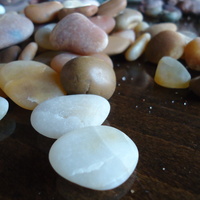Conference Presentations by Adrien Mamou-Mani
Papers by Adrien Mamou-Mani
Adjusting the soundboard’s modal parameters without mechanical change: A modal active control approach
The Journal of the Acoustical Society of America, 2014
Recent works on the (psycho-)acoustics of wind instruments
The Journal of the Acoustical Society of America, 2014
Applied Acoustics, 2011
Two mass-produced trumpets of the same model type have been shown to exhibit significant acoustic... more Two mass-produced trumpets of the same model type have been shown to exhibit significant acoustical differences [6] due to the presence of a tiny leak in the bore of one of the two instruments. In this paper, psychophysical experiments are presented which demonstrate that these acoustical differences do not necessarily result in perceptible differences in the playing characteristics of the two trumpets. In particular, during a listening test, very few musicians discriminate successfully between sounds produced by each trumpet. Similarly, only a small number of trumpet players successfully distinguish between the instruments when subjected to a playing test, although those that do are shown to be able to provide distinct and consistent quality assessments for each one.
Applied Acoustics, 2010
2010). Evaluating the suitability of acoustical measurement techniques and psychophysical testing... more 2010). Evaluating the suitability of acoustical measurement techniques and psychophysical testing for studying the consistency of musical wind instrument manufacturing. Applied Acoustics, 71(7), pp. 668-674.
Investigating the history of the piano action using scientific calculus: The case of an Érard grand piano from 1802
Précontraintes et vibration des tables d'harmonie: vers une modélisation du savoir-faire des fabricants d'instruments de musique

Investigating the consistency and quality of musical wind instrument manufacturing
ABSTRACT For large-scale musical wind instrument manufacturers, the ability to produce instrument... more ABSTRACT For large-scale musical wind instrument manufacturers, the ability to produce instruments in a repeatable fashion is essential. However, despite the tight manufacturing tolerances used, professional musicians are often able to discern small, but perceptible, differences between the playing characteristics of instruments manufactured in an identical way. These differences are most likely a result of tiny disparities in bore profile or in the positioning/sealing of any side holes. This talk outlines a programme of work designed to investigate the consistency with which manufacturers are able to make wind instruments and to explore the causes of any musical differences between the instruments. State-of-the-art techniques will be used to measure the internal geometries and resonance characteristics of batches of nominally identical instruments. Meanwhile, the musical qualities of the instruments will be established through a series of psychoacoustical tests. The potential effectiveness of the proposed approach will be demonstrated through a set of measurements made on two low-cost, mass-manufactured trumpets.
Physical and perceptual differences between two trumpets of the same model type

Acta Acustica united with Acustica, 2011
Capillary-based systems for measuring the input impedance of musical wind instruments were first ... more Capillary-based systems for measuring the input impedance of musical wind instruments were first developed in the mid-20th century and remain in widespread use today.Inthis paper,the basic principles and assumptions underpinning the design of such systems are examined. Inexpensive modifications to acapillary-based impedance measurement set-up made possible due to advances in computing and data acquisition technology are discussed. The modified set-up is able to measure both impedance magnitude and impedance phase even though it only contains one microphone. In addition, amethod of calibration is described that results in asignificant improvement in accuracywhen measuring high impedance objects on the modified capillary-based system. The method involves carrying out calibration measurements on twodifferent objects whose impedances are well-known theoretically. The benefits of performing twoc alibration measurements (aso pposed to the one calibration measurement that has been traditionally used)are demonstrated experimentally through input impedance measurements on twotest objects and aBooseyand Hawkes oboe.

An active mute for the trombone
The Journal of the Acoustical Society of America, 2015
A mute is a device that is placed in the bell of a brass instrument to alter its sound. However, ... more A mute is a device that is placed in the bell of a brass instrument to alter its sound. However, when a straight mute is used with a brass instrument, the frequencies of its first impedance peaks are slightly modified, and a mistuned, extra impedance peak appears. This peak affects the instrument's playability, making some lower notes difficult or impossible to produce when playing at low dynamic levels. To understand and suppress this effect, an active mute with embedded microphone and speaker has been developed. A control loop with gain and phase shifting is used to control the damping and frequency of the extra impedance peak. The stability of the controlled system is studied and then the effect of the control on the input impedance and radiated sound of the trombone is investigated. It is shown that the playability problem results from a decrease in the input impedance magnitude at the playing frequency, caused by a trough located on the low frequency side of the extra imped...
Simulated Effects of Combined Control of an Experimentally Identified Soundboard
ABSTRACT cote interne IRCAM: Benacchio13a
Combined State and State Derivative Control Applied to Musical String Instruments
ABSTRACT cote interne IRCAM: Benacchio13c
La présence d'une sourdine sèche modifie sensiblement l'impédance d'entrée des instruments de mus... more La présence d'une sourdine sèche modifie sensiblement l'impédance d'entrée des instruments de musique de type cuivre, induisant des changements fréquentiels des premiers pics, ainsi que l'apparition d'un pic supplémentaire. Ce pic influe sur la jouabilité de l'instrument, rendant parfois difficile voire impossible le jeu des notes graves. Un prototype de sourdine avec microphone et haut-parleur intégrés est présenté. Grâceà une boucle de contrôle en gain et déphasage entre le microphone et le haut-parleur, le pic supplémentaire est déplacé en fréquence et en amortissement, ce qui rend possible le jeu des notes graves. Les effets de cette "sourdine active" sur l'impédance d'entrée d'un trombone ainsi que sur le son rayonné sont présentés.

Acta Acustica united with Acustica, 2014
Modal active control enables modifications of the damping and the frequencies of the different re... more Modal active control enables modifications of the damping and the frequencies of the different resonances of a system. A self-sustained oscillating wind instrument is modelled as a disturbance coupled to a resonator through a non-linear coupling. The aim of this study is to present simulations of modal active control applied to a modeled simplified self-sustained oscillating wind instrument (e.g. a cylindrical tube coupled to a reed, which is considered to approximate a simplified clarinet), incorporating collocated speaker, microphone and a reed. The next goal will be to apply this control experimentally and to test it with musicians. Copyright: c 2013 Thibaut Meurisse, Adrien Mamou-Mani, Rene Causse et al. This is an open-access article distributed under the terms of the Creative Commons Attribution 3.0 Unported License, which permits unrestricted use, distribution, and reproduction in any medium, provided the original author and source are credited.

Experimental Demonstration of the Modification of the Resonances of a Simplified Self-Sustained Wind Instrument Through Modal Active Control
Acta Acustica united with Acustica, 2015
ABSTRACT This paper reports the experimental results of modifying the resonances of wind instrume... more ABSTRACT This paper reports the experimental results of modifying the resonances of wind instruments using modal active control. Resonances of a simplified bass clarinet without holes (a cylindrical tube coupled to a bass clarinet mouthpiece including a reed) are adjusted either in frequency or in damping in order to modify its playing properties (pitch, strength of the harmonics of the sound, transient behaviour). This is achieved using a control setup consisting of a co-located loudspeaker and microphone linked to a computer with data acquisition capabilities. Software on the computer implements an observer (which contains a model of the system) and a controller. Measuring and adjusting the transfer function between the speaker and microphone of the control setup enables modifications of the input impedance and the radiated sound of the instrument.

Cetteétude se place dans le cadre général du contrôle actif appliqué aux instruments de musique. ... more Cetteétude se place dans le cadre général du contrôle actif appliqué aux instruments de musique. Elle permet la modification des paramètres acoustiques d'une structure simple de type clarinette (résonateur cylindrique + excitateur de type anche simple). L'objectif de l'étude est d'examiner les liens entre les modifications induites par le contrôle actif et les modifications perceptives qui en découlent pour un instrumentiste. Pour cela nous développons une méthodologie expérimentale basée, d'une part, sur le développement de filtres numériques permettant de modifier l'amplitude et la fréquence des différentes résonances du tube, et d'autre part sur un protocole original de test perceptif, en situation de jeu, permettant de quantifier des jugements de dissemblance et de produire un ensemble de champs lexicaux issus d'une verbalisation libre. Les premiers résultats permettent de dégager des attributs communs aux musiciens, et notamment trois critères sur lesquels se basent les différences perçues pour différentes situations de contrôle : facilité de jeu, ouverture et richesse harmonique. L'étude montré egalement une relative corrélation entre les paramètres physiques du contrôle et ces dimensions perceptives principales.

Mode tuning of a simplified string instrument using time-dimensionless state-derivative control
Journal of Sound and Vibration, 2015
ABSTRACT In recent years, there has been a growing interest in smart structures, particularly in ... more ABSTRACT In recent years, there has been a growing interest in smart structures, particularly in the field of musical acoustics. Control methods, initially developed to reduce vibration and damage, can be a good way to shift modal parameters of a structure in order to modify its dynamic response. This study focuses on smart musical instruments and aims to modify their radiated sound. This is achieved by controlling the modal parameters of the soundboard of a simplified string instrument. A method combining a pole placement algorithm and a time-dimensionless state-derivative control is used and quickly compared to a usual state control method. Then the effect of the mode tuning on the coupling between the string and the soundboard is experimentally studied. Controlling two vibration modes of the soundboard, its acoustic response and the damping of the third partial of the sound are modified. Finally these effects are listened in the radiated sound.
Modal proportional and derivative state active control applied to a simplified string instrument
Journal of Vibration and Control, 2015
Impulse Planar Nearfield Acoustics Holography (IPNAH)











Uploads
Conference Presentations by Adrien Mamou-Mani
Papers by Adrien Mamou-Mani